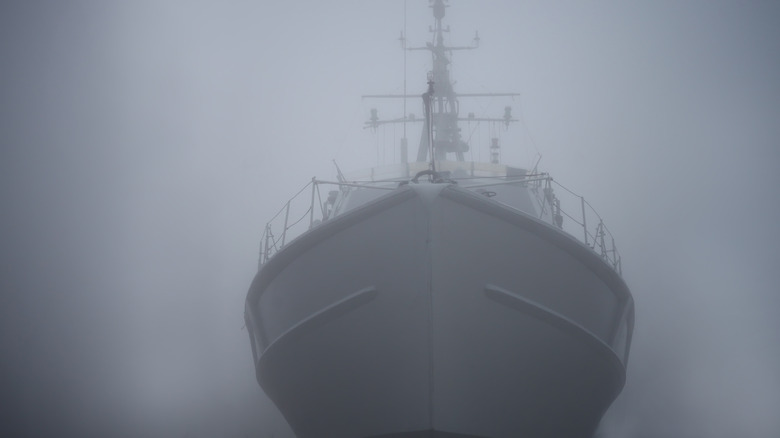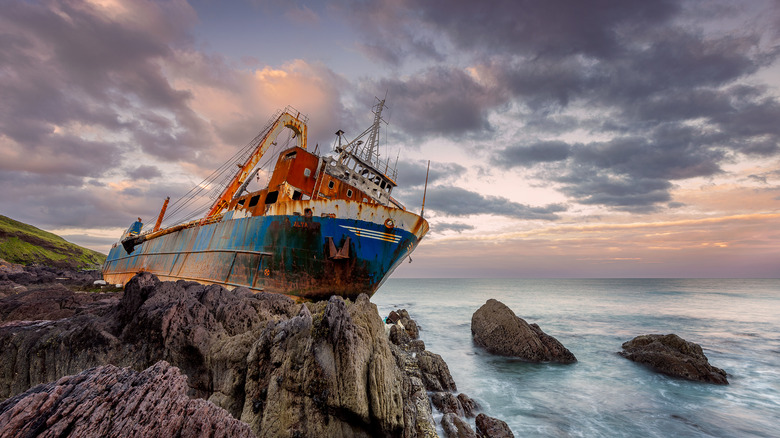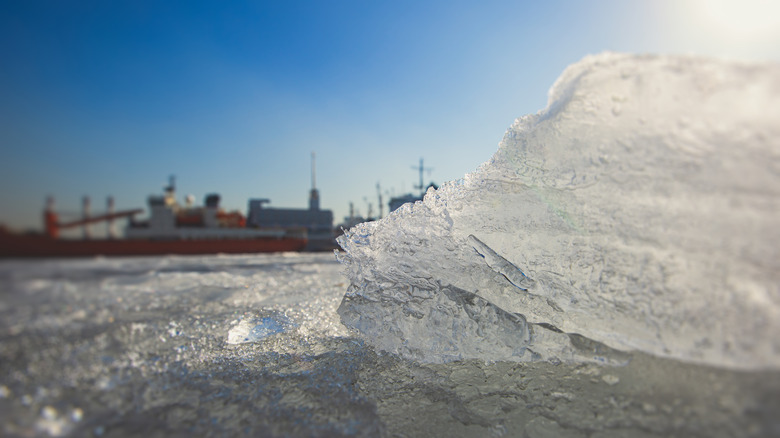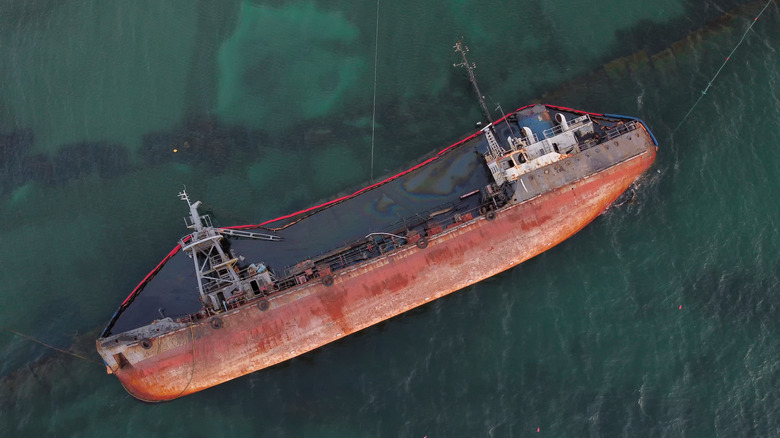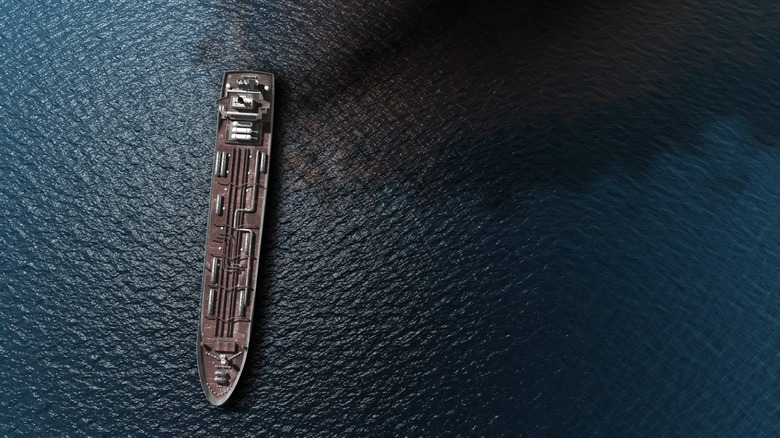What We Know About The Real Life Ghost Ships That Are Sailing The World Without Crews
If someone were to bring up the topic of ghost ships, the first thought that might come to many people's minds would probably be something along the lines of a creepy ghost-infested vessel lost at sea or a ship that is a ghost itself. While there are plenty of legends and nightmare-fuel-style stories about these types of ghost ships, another slightly more tangible ghost ship exists even in modern times.
What's eerie but in some ways obvious is that ships will still remain afloat and move around on the water if left empty, carried along by the winds and currents of the sea to nowhere in particular. Today's ghost ships are vessels found adrift on the ocean, pushing ahead with the help of the elements.
The first recorded ghost ship in history was the SV Sea Brig in the 1700s, according to Crime Reads. When the ship ran ashore in Rhode Island, it appeared to have been abandoned by the captain and crew within sight of land. Oftentimes modern ghost ships are much less mysterious than the SV Sea Brig and have somewhat more logical reasons for their undirected sailing.
Technical issues can cause a ship to be too much of a hassle to repair
Much less scary than other possible ghostly marine legends is that some ships simply wind up free sailing due to mechanical or technical difficulties. This is what happened to a 250-foot-long cargo carrier, the MV Alta. The massive, 2,400-ton ship lost power while sailing from Greece to Haiti in 2018. According to Surfline, the vessel lost power around 1,300 miles from the destination, and while the repair efforts went on for weeks, they were unsuccessful.
Eventually, the crew's efforts were forced to come to a complete halt when a hurricane posed a threat to their safety. They were evacuated, and the MV Alta left behind for good. A British Royal Navy ice patrol boat saw the MV Alta once more in 2019 in the mid-north Atlantic before the ship was spotted by a jogger five months later at its final resting place, when it ran ashore on Ireland's southern coast.
Fortunately, the MV Alta's fate seems to be a rare case when it comes to technical difficulties. But power troubles aren't the only reason so many ships sail the seas with little to no crew left aboard.
Sometimes nature is a ship's worst enemy
While out at sea, it's hard for ships to avoid succumbing entirely to the forces of nature, and some aren't successful. In August of 1854, the HMS Resolute became trapped in Arctic ice while searching for a lost expedition that had been searching for the Northwest Passage. Then, in September 1855, the Resolute was seen by the crew of the George Henry, an American ship, floating more than 1,200 miles from where it was stuck, according to Crime Reads. The Americans returned the ship to England, and when the ship was decommissioned, wood was taken from the ship that was used to build the Resolute Desk in the oval office of White House, per The President's Desk – a gift from Queen Victoria to the United States (per White House History). Another ship trapped in ice is the Baychimo, which was last seen in 1969 after sailing without a crew for 38 years.
Ice isn't the only force of nature to birth ghost ships, however, as the 9.0 magnitude earthquake followed by a tsunami that devastated Japan on March 11, 2011, carried the ship Ryou-Un Maru out to sea from a scrap yard. Initially, salvage crews believed the vessel had sunk, but in March 2012, it was seen once more by a Royal Canadian Air Force plane in Canadian waters, and a tracking buoy was placed on it. According to Surfline, the ship was later declared an environmental hazard and was destroyed once it entered U.S. waters.
Salvaging these vessels is encouraged
When an unmanned or inoperable vessel sails into international waters, the ability to salvage or restore it becomes limited. In 1976, the Lyubov Orlova cruise ship was commissioned by the USSR to transport 110 men through the Arctic and Atlantic, according to Surfline. The vessel was seized and kept in Newfoundland, where it became infested with rats until its attempted transport to the Dominican Republic to be scrapped. The transport failed, and the ship sailed into international waters, where it was abandoned for good. The vessel was last seen in 2014, still sailing.
These vessels are often left afloat with supplies on them, and according to an article published by Bluestein Law Firm P.A., maritime salvage is often encouraged and rewarded. The ships left to float the seas, even if they don't possess much in the realm of cargo, could possibly pose a danger to the environment or any other watercraft that may encounter them. Individuals and companies willing to partake in salvage activities are not only rescuing supplies but possibly lives as well.
The COVID 19 pandemic has greatly influenced the number of abandoned ships
In more recent times, another reason for ships being left at sea has been on the rise: money. According to Statistica, in 2020, the number of ships abandoned grew by 80% compared to the year before. This is largely attributed to the COVID 19 pandemic, only this time, it's not just the ship being abandoned, but the crew as well, with over 70 ships and 1,000 crew members being abandoned in 2020 alone. While organizations like mariners unions have tried to put protections in place for seafarers' rights, places like the UAE have not signed any agreements to protect the rights of the crew, making it a hot spot for abandoned ships.
When the shipowners don't pay their crew for months or don't cover the cost of getting them back home, the ship is considered abandoned, per The Wall Street Journal. So when companies find themselves in a tough spot financially, they may leave the boat and its crew adrift. Countries like China, Indonesia, and the Philippines established a seafarers' mutual emergency fund to aid these abandoned crews with things like food and supplies, but some of the staff left behind surprisingly will refuse to leave the ship.
Some of the abandoned crew refuse to leave the vessels behind
While some governments force the crew to remain aboard the vessel until the shipowners have paid what they owe, other employees have different reasons for staying. When a shipowner abandons their vessel due to an inability to pay their debts, that generally means the employees on board are abandoned as well. According to The Wall Street Journal, many of these left-behind workers refuse to leave, as they're often owed thousands of dollars, and leaving the ship means there's a high chance they won't get paid.
So maybe the modern-day ghost ship doesn't seem quite as eerie as the legends of such ships as The Flying Dutchman or other ghostly seafaring entities, but one might argue that a crew being abandoned or trapped on a ship without power or left behind due to financial strains would be just as frightening for those involved. Either way, plenty of ships on the sea endlessly sail along, waiting to run aground or sink to their watery grave, never to be seen again.
